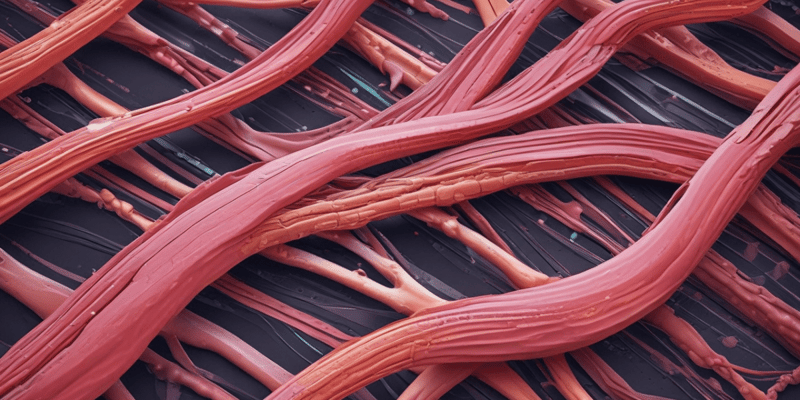Podcast
Questions and Answers
What are the main components of a muscle fiber?
What are the main components of a muscle fiber?
The main components of a muscle fiber are myofibrils, sarcomeres, and the sarcoplasmic reticulum.
How does the resting length of a muscle affect the force it generates?
How does the resting length of a muscle affect the force it generates?
The resting length of a muscle affects force generation through the length-tension relationship, where optimal overlap of actin and myosin filaments results in maximum tension.
What are the two main methods to vary the strength of skeletal muscle contraction?
What are the two main methods to vary the strength of skeletal muscle contraction?
The two main methods are tetanus/tetany and the recruitment of motor units.
What is the significance of cardiac muscle action potential for muscle contraction?
What is the significance of cardiac muscle action potential for muscle contraction?
Signup and view all the answers
Describe the mechanism of contraction for cardiac muscle.
Describe the mechanism of contraction for cardiac muscle.
Signup and view all the answers
Outline the contraction mechanism for smooth muscle.
Outline the contraction mechanism for smooth muscle.
Signup and view all the answers
What are the key differences between smooth, cardiac, and skeletal muscle?
What are the key differences between smooth, cardiac, and skeletal muscle?
Signup and view all the answers
Explain the concept of tetanus in skeletal muscle contraction.
Explain the concept of tetanus in skeletal muscle contraction.
Signup and view all the answers
What role do motor units play in muscle contraction strength?
What role do motor units play in muscle contraction strength?
Signup and view all the answers
Why is optimal sarcomere length important for muscle contraction?
Why is optimal sarcomere length important for muscle contraction?
Signup and view all the answers
Study Notes
Muscle Components
- Muscle fiber components: myofibrils, sarcomeres, actin, myosin.
Muscle Length and Force
- The amount of force a muscle can generate during contraction is dependent on its resting length.
- At optimal resting length, the sarcomere can achieve maximum strength of contraction.
- If the muscle is overstretched, there is no overlap between actin and myosin, which leads to minimal force generation.
Skeletal Muscle Force Modulation
- Muscle force can be altered through tetanus and motor unit recruitment.
Tetanus
- Tetanus or tetany is a sustained muscle contraction.
- At high levels of stimulation, the sustained rise in intracellular calcium leads to greater force than during a single twitch.
Motor Units
- A motor unit consists of an alpha motor neuron and all the muscle fibers it innervates.
- Larger motor units provide less precise muscle control than smaller motor units.
- Smaller motor units are recruited first to generate force, and as more force is needed, larger motor units are recruited.
- During prolonged muscle contraction, motor units rotate to prevent fatigue.
Length-Tension Curve
- Increasing muscle length leads to increased tension, but there is a limit.
- An optimal resting length is essential for maximal strength of contraction.
Studying That Suits You
Use AI to generate personalized quizzes and flashcards to suit your learning preferences.
Related Documents
Description
Test your knowledge on the components of skeletal muscle, the relationship between muscle length and force, and the mechanisms of force modulation such as tetanus and motor unit recruitment. Explore how these principles apply to muscle contraction and performance.




